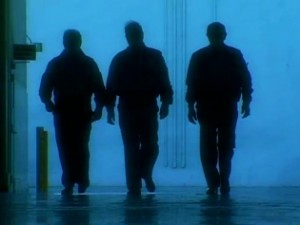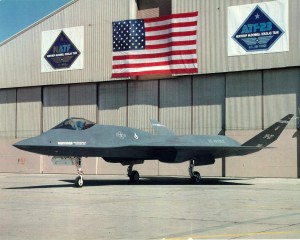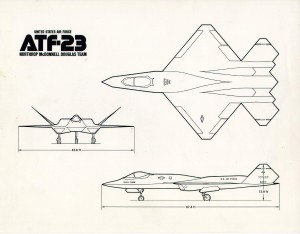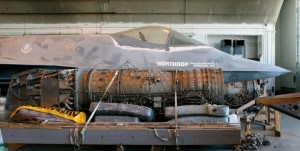THE BLACK WORLD
“One of the characteristics of working in the black world is that the more you know, the more deeply you have to bury what you know. “
The YF-23 Program generated many truckloads of documents during its 10-year development. One of the program managers is quoted as saying that when the weight of the documentation equaled the weight of the airplane they knew that they were near completion.
A documentary film can only include a limited amount of the information to tell its story. Here are additional thoughts from some of the key people that didn’t make it into the documentary. We think they provide valuable insights into this remarkable era of aviation history.
Bob Sandusky- Chief Engineer
“The development of an airplane is really a packaging problem. It’s the same problem that the supermarket has with how many pork chops can you put in a package.”
“There’s a certain synergism between stealth and aerodynamics. If it looks right It’ll fly right, and that’s true. Its also true with stealth design. If its smooth and flowing and aligned properly…it will be very hard to see. So all of that was kept in mind from the very first line on the very first sheet of paper.”
“I remember we had to give lots of talks to retirement groups and things like that, and I described one of the tests where you fly a chicken at the canopy at 300mph and one lady raised her question, says “how do you get a chicken to fly that fast?” And I really…didn’t know how to answer that.”
“This was something that I had put ten years of my life into. From that first line on the airplane, through the preparation of the full scale development proposal was ten years of my life. That’s quite a bit of a career to put on a concept from the very first line on a piece of paper.”
(ON THE BLACK WIDOW DESIGNATION)
“When we did our first radar tests of the airplane, we realized that the radar signature from the leading and trailing edges of the wing and the wing tips formed an RCS pattern that looked exactly like a spider. And I don’t remember who it was that said, “Black Widow II…it has to be”. And from then on, those of us on the team, that was the only name for the airplane. So we had the name Black Widow 2 actually before there was a competition for the ATF.”
(ON THE ENGINES)
“We put a pair of P&W engines in one prototype, PAV1, and set of GE engines in the second one. Now I suppose we coulda put a P&W engine on one side, and a GE on the other side and see which way the airplane turned, so see which was the faster…but we didn’t do that.”
“We designed the airplane to fit the bigger of the two engines. So we wrapped the airplane around the P&W engine, and then we actually had to build a little bit of a spacer on the second prototype to make sure the GE engine didn’t rattle around inside the airplane.”
“Pratt &Whitney did their engine testings out in the Florida swamps so that they’d be away from population. Well they put in a PGA golf course many years later, and civilization moved out there. And the people got used to the sound because they tested mostly at night. And the alligators got used to the sound cause they tested mostly at night. But the first time they ran the engine in full afterburner, on the test stand at Pratt & Whitney, there were reports the next morning of alligators climbing the fences of people’s homes and diving into the swimming pools to get away from the noise. That’s a dramatic demonstration of the power of those engines.”
(ON THE HANGAR AT EDWARDS)
“The shelter was designed in a way that it was equal, but separate. There was a separate entrance for Lockheed and a separate entrance for Northrop. And a common wall down the middle. The one part was that the wall didn’t go up quite high enough.”
“We beat Lockheed up to the hangar by a couple of months. When they got there one of the things we did was take one of the latex gloves that the mechanics use and fill it with helium and fold all the fingers down but one, and float it over the top of the wall.”
Steve Smith – Program Manager
(ON THE BLACK WORLD)
“A Black Program, by definition, is like a black hole. That is that anything that enters into a black hole never comes out…cause the pull of gravity on it is so great. The best way to keep something secure is to have no one know about it, so they won’t try to penetrate it.”
“In the Black World, you have a special environment of comradeship among all those people who are in it with you, because you suffer the same problems together. In an isolated fashion that you can’t talk to anybody else about it, including your family. So it gives you sort of a dual personality, like you’re in two families. You’re in the Black family, and the family you go home and eat dinner with.”
(ON THE YF23)
“If you think that the ultimate in technology advancement and aerodynamic design and systems engineering is the most efficient way to get from one place to another or to accomplish a job, those two airplanes (the Yf-23 and the B2) are the most efficient airplane designs I’ve ever seen.”
“All of my life I’ve been devoted to the fighter and the small maneuverable aircraft side of the business. The T-38, the F-5, the F5G the F20…and these were aircraft that were capable of flying at very high angles of attack and pulling very high load factors at that high altitude efficiently, so that the pilot could turn, and turn inside his opponent, and get a lead shot on him in any case. And of all those aircraft the YF23 was the most superior… beyond comprehension…of anything I’d ever seen or thought about in my career.”
“The technical innovations of the YF23…and the ones that are least understood and least discussed, represent about 50% of the value and advancement of that aircraft and that’s the avionics suite. Avionics are the flight control computers. We developed a new computer technology capability on that airplane that had essentially supercomputers in the air…And the airplane when it flew, flew like no other airplane. There were six major flight control surfaces that worked in concert. The control systems weren’t connected together with wires, each was separately controlled by the computer. So when a standard airplane would roll, it rolls in a non-linear way, which you’ve seen in airshows. When this airplane would roll, it would roll like an arrow. It had a mind of its own.”
QUESTION: So how fast did it go?
“The supercruise speed is classified. I believe there was a news release that said it was in the neighborhood of some number, but I don’t recall so I’m not going to tell you the number that’s in my mind. The maximum speed…its called a Mach Two class airplane. And that’s all I’ll say about that.”
(ON STEALTH)
“What is not appreciated and is probably most highly classified about stealth and so I’ll talk the least about it, and that’s one of the reasons you don’t hear much about it is …how you can operate all the multiple systems you have to operate today in the electronic environment of the world, so you can direct your weapons accurately…so that you’re still maintaining your secrecy and your defensive survivability. Sensing and tracking and detecting and all those things have to be done not just from defending yourself against what’s on the ground, but must be part of your attack capability. Its an awesome task.”
“It’s like imagining what a rock group would do if they had to perform in front of an audience with an amplifier system that had no amplification.”
Tom Rooney – Program Manager
“I’m quite sure that some of the features that were demonstrated on this airplane…and on the YF22..will find their way onto the next airplane. Each technology is not lost. Its documented. And its available to people who are at least accessed to the data. What is lost is the synergy of an entire team putting something together.”
Tony Chong – Master Model Maker
“Part of the advantage of being a modelmaker is that you don’t rivet a spar and then pass it on to the next guy like you do in production. You get to build the whole thing…So as you are building this object, you start to feel the curves and the shape in your hands. And if it’s a beautiful airplane you fall in love with it. It’s a thing of beauty. It’s a machine that’s alive, because the power that’s in it, the beauty that’s in it…and in some sense the danger that’s inherent in a warplane. And a warplane with the lines is beautiful…deadly. The YF23 was such a beautiful airplane to look at.”
“I suppose that’s a funny way of looking at it, but yes…people that fall in love with an airplane love it. That’s why its predominantly a male profession—aerospace. That’s why ships have female names. That’s why airplanes have female names. You get more female engineers, they’ll start to have boy names. Black Widow…female name…deadly.”
Thomas Jones – CEO, Northrop 1959-90
“An airplane is a combination of many technical elements, the aerodynamics and the engine and the structures. And you might say they compete with one another in a sense, but to orchestrate that whole so that it plays perfectly and comes out is the real accomplishment. If you talk to any of our people working on the program each would have a list of things that had never been done before. There were so many innovations…pages and pages of innovations that taken by themselves are quite amazing. But for me it was all of these advances being put together in the performing system…is the miracle.”



